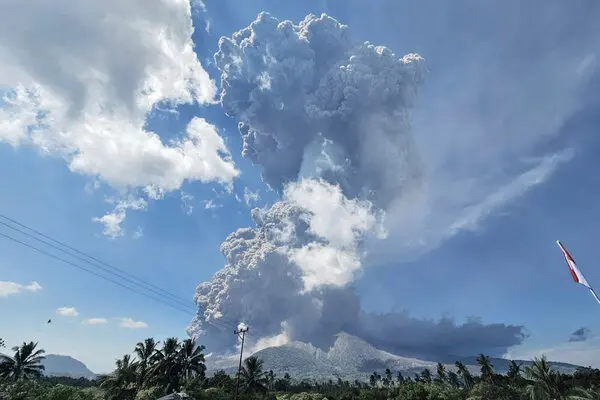Indonesia’s Mount Lewotobi Laki-Laki erupted violently early Monday morning, spewing a colossal ash plume up to 18 kilometers (nearly 60,000 feet) into the atmosphere. The dramatic event forced widespread flight cancellations, emergency evacuations, and an elevated alert level from Indonesian authorities, marking one of the most powerful volcanic eruptions in Southeast Asia this decade.

Eruption Overview: Massive Ash Tower and Lava Activity
The volcanic activity began intensifying late Sunday night, culminating in a high-energy eruption just after dawn. According to the Volcanology and Geological Disaster Mitigation Agency (PVMBG), the eruption produced:
-
Ash columns reaching the stratosphere—potentially disrupting global air routes.
-
Lava flows and pyroclastic surges moving up to 8 kilometers from the crater.
-
Continuous thunder-like rumbling and glow emissions visible from surrounding districts.
This is the third major eruption of Mount Lewotobi Laki-Laki in 2025, following two earlier events in March and June. The volcano had already been on the radar of Indonesian disaster agencies after the deadly November 2024 eruption that claimed nine lives and displaced over 5,000 people.
Aviation Disruption and Exclusion Zones
The scale of this eruption triggered immediate closure of regional airspace, including:
-
Ngurah Rai International Airport in Bali: Several inbound and outbound international flights were grounded.
-
Domestic flights to and from East Nusa Tenggara and nearby islands were suspended.
-
Flight paths to Australia, Singapore, and South Korea were re-routed or canceled due to high-altitude ash clouds.
Indonesia’s Meteorology, Climatology, and Geophysics Agency (BMKG) issued aviation color code RED, signaling serious risk to aircraft operations. Satellite imagery confirmed ash dispersion at cruising altitudes, causing global aviation alerts.
Evacuation and Public Safety Measures
The alert level was raised to IV, the highest on Indonesia’s hazard scale. Emergency teams expanded exclusion zones to 7 kilometers and advised all residents within that radius to evacuate immediately.
The National Disaster Mitigation Agency (BNPB) confirmed:
-
Over 3,000 residents have been moved to shelters in East Flores.
-
Local schools and public offices near Lewotobi have been temporarily closed.
-
Distribution of face masks, clean water, and food supplies is underway in affected zones.
Authorities also warned of lahars—dangerous mudflows formed by ash mixing with rainfall—which are particularly threatening during the ongoing monsoon season. Rivers flowing from the volcano are being closely monitored.
Indonesia’s Volcanic Reality
Mount Lewotobi Laki-Laki is part of a twin volcano system in Flores Island, East Nusa Tenggara province. At 1,584 meters, the volcano has had a history of moderate eruptions, but the frequency and intensity in recent months suggest heightened tectonic activity.
Indonesia, situated on the Pacific Ring of Fire, is home to over 120 active volcanoes—the most of any country in the world. It has witnessed some of the deadliest eruptions in history, including Krakatoa in 1883 and Mount Merapi in 2010.
Scientific and Environmental Outlook
Volcanologists believe this eruption could have short-term climatic effects, as stratospheric ash injections can temporarily cool global temperatures. The sheer height of the ash plume also raises concerns about ozone layer interaction and regional weather disruptions.
Seismologists continue to monitor tremors beneath Lewotobi’s caldera, with reports of ongoing magma movement indicating the potential for follow-up eruptions. Authorities are advising residents in surrounding regions to remain alert and prepare for extended displacement.
The latest eruption of Mount Lewotobi Laki-Laki is a stark reminder of Indonesia’s dynamic and volatile geology. With tens of thousands affected and air traffic across Southeast Asia disrupted, the nation now braces for possible aftershocks, further eruptions, and long-term impacts on tourism, infrastructure, and environmental safety.




